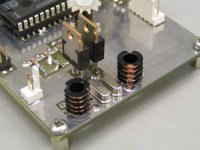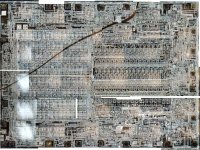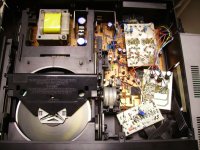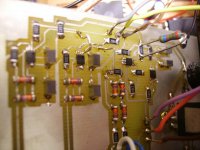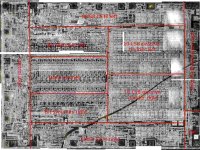Hi studiostevus,
They are custom made screened 4-segment 100uH air chokes (attached photograph). The reason for using multiple segments is to minimize stray capacitance.
I had to improvise in order to support 2 different types of chokes (footprint) and a screen that has 2 more contacts. The CAD package requires one unique pin number for each pin, so I had to use 6 contacts in the schematics.
John, what are the chokes in the master clock generator? I am not familiar with the symbol even...
They are custom made screened 4-segment 100uH air chokes (attached photograph). The reason for using multiple segments is to minimize stray capacitance.
I had to improvise in order to support 2 different types of chokes (footprint) and a screen that has 2 more contacts. The CAD package requires one unique pin number for each pin, so I had to use 6 contacts in the schematics.
Attachments
My Autographs never sounded so good; so revealing, even with the Beyma coaxial instead of true Tannoy; so deep and powerful bass; so warm and textured the timbres od instruments and voices!
Some picks:
Picasa Web Albums - mauricio
Cheers,
M.
Cotton isolator. Classy!
Cotton isolator. Classy!
Oh! Thank you.
That DAC is still on duty... not made were made, I guess.
USB microscope capture (38 photos in one)
Hi,
I've made some photos of a damaged TDA1541A with an USB microscope, at 400x. It is not a quality one, but now, we can get an idea of the magnificent work done by the engineers at Philips.
Enjoy it........
Hi,
I've made some photos of a damaged TDA1541A with an USB microscope, at 400x. It is not a quality one, but now, we can get an idea of the magnificent work done by the engineers at Philips.
Enjoy it........
Attachments
TDA1541A photos
Hi,
I've opened it using heat, I do this since I have 14 years old, now I'm 38. I've opened hundreds, since watches, intel 286, 386, math coprocessor, 486 and amd too, Wolfson 8741, PCM1704K, PCM63K, many and more, until celular phones ones.
Yes, it's the entire chip, a broken one. You can count the 28 pins all along the perimeter.
Regards,
I'm happy you like the photo.
Hi,
I've opened it using heat, I do this since I have 14 years old, now I'm 38. I've opened hundreds, since watches, intel 286, 386, math coprocessor, 486 and amd too, Wolfson 8741, PCM1704K, PCM63K, many and more, until celular phones ones.
Yes, it's the entire chip, a broken one. You can count the 28 pins all along the perimeter.
Regards,
I'm happy you like the photo.
Hi,
I've opened it using heat, I do this since I have 14 years old, now I'm 38. I've opened hundreds, since watches, intel 286, 386, math coprocessor, 486 and amd too, Wolfson 8741, PCM1704K, PCM63K, many and more, until celular phones ones.
Yes, it's the entire chip, a broken one. You can count the 28 pins all along the perimeter.
Regards,
I'm happy you like the photo.
Hi galeb,
You mean you toast the chip with a blow torch?
Chip toasting....
Hi QSerra Tico Tico, not this exactly. I use a gas kitchen fire. I take the chip or the device of my interest with an universal plier, and I put the chip very very near the fire, touching it, for some seconds, even some minutes, and with the extractor fan on, and I wait until the chip plastic becomes a little "white". Then I let it on a plate and wait some minutes until it cools, and then, with my fingers, under running water, very carefully I remove the plastic until I can see the chip. I clean the rests of plastic and I finish extracting the rest of plastic and clean it with water. Maybe the first pieces you try don't work, but with a little practice you finally can do it without problem. It's like solder. Last day I've solded the 4 flip flop smd for the TDA1541A signal treatment of John's design. Because I have more than 21 years in soldering I can do it without problems and quickly. See enclosed photo of my Philps CD player of the 85'. Yes, I now it's a dirty job, but it's sound is incredible now. You can see from top to down: audio out, signal tratment, and my clock, not the last version, but a good one (-171dbc/hz). And respect to the treatmen signal pcb, you can see near the 1206 resistors the chips. Yes I now the resistors are big, but I hadn't at hand other components.
PD: John, thank you very much for your knowledge and for sharing it with us.
Now the CD player sounds with a silence level that remains me a turntable. The detail level, tonal precision, naturality and soundstage is now as real as real music.
Hi QSerra Tico Tico, not this exactly. I use a gas kitchen fire. I take the chip or the device of my interest with an universal plier, and I put the chip very very near the fire, touching it, for some seconds, even some minutes, and with the extractor fan on, and I wait until the chip plastic becomes a little "white". Then I let it on a plate and wait some minutes until it cools, and then, with my fingers, under running water, very carefully I remove the plastic until I can see the chip. I clean the rests of plastic and I finish extracting the rest of plastic and clean it with water. Maybe the first pieces you try don't work, but with a little practice you finally can do it without problem. It's like solder. Last day I've solded the 4 flip flop smd for the TDA1541A signal treatment of John's design. Because I have more than 21 years in soldering I can do it without problems and quickly. See enclosed photo of my Philps CD player of the 85'. Yes, I now it's a dirty job, but it's sound is incredible now. You can see from top to down: audio out, signal tratment, and my clock, not the last version, but a good one (-171dbc/hz). And respect to the treatmen signal pcb, you can see near the 1206 resistors the chips. Yes I now the resistors are big, but I hadn't at hand other components.
PD: John, thank you very much for your knowledge and for sharing it with us.
Now the CD player sounds with a silence level that remains me a turntable. The detail level, tonal precision, naturality and soundstage is now as real as real music.
Attachments
Hi galeb,
Impressive photograph of the TDA1541A chip, I see you have merged multiple photographs.
I rotated the picture and added an overlay (IEEE journal of solid-state circuits, vol. sc-21, no. 3, June 1986), indicating major TDA1541A sections.
Impressive photograph of the TDA1541A chip, I see you have merged multiple photographs.
I rotated the picture and added an overlay (IEEE journal of solid-state circuits, vol. sc-21, no. 3, June 1986), indicating major TDA1541A sections.
Attachments
With this Mk7 requiring a slaved transport, which I agree is ideal but unforunately this makes it no longer a "DAC", iow it is integrated to the transport. Which leaves only two real options: an SD player or a CDP.
So if you like Foobar, VST's, having 3 TBs of music a click away you are out of luck. This is a big step in a different direction than the original subject of the thread.
It may be possible to send the Mk7's clock thru a pulse transformer over to an asynch USB-I2s device ( one that drives the computer with a 11.2896 clock), but the complications of sending a clock signal several inches needs study I think. But at least we would have a standalone usb DAC.
One possibly stupid suggestion would be the WM8804 receiver. With the old CS receivers you couldn't slave them to a clock on the DAC side because of timing differences with the transports clock. However the WM8807 uses a PLL to synchonously reclock the I2S using an separate crystal oscillator (even an 11289.6mhz one) . I am wonding if the Mk7 design could be integrated into a standalone DAC by using using the WM8804 to output the data and wordclock and using the masterclock clock for the Mk7 reclocking as well as driving the WM8807 pll.
I have no idea if either of these ideas could be made to work, but I think it would be ashame to relegate the Mk7 , pigeonholed into to being a CDP output stage rather than an independant external DAC which is the subject of this thread.
So if you like Foobar, VST's, having 3 TBs of music a click away you are out of luck. This is a big step in a different direction than the original subject of the thread.
It may be possible to send the Mk7's clock thru a pulse transformer over to an asynch USB-I2s device ( one that drives the computer with a 11.2896 clock), but the complications of sending a clock signal several inches needs study I think. But at least we would have a standalone usb DAC.
One possibly stupid suggestion would be the WM8804 receiver. With the old CS receivers you couldn't slave them to a clock on the DAC side because of timing differences with the transports clock. However the WM8807 uses a PLL to synchonously reclock the I2S using an separate crystal oscillator (even an 11289.6mhz one) . I am wonding if the Mk7 design could be integrated into a standalone DAC by using using the WM8804 to output the data and wordclock and using the masterclock clock for the Mk7 reclocking as well as driving the WM8807 pll.
I have no idea if either of these ideas could be made to work, but I think it would be ashame to relegate the Mk7 , pigeonholed into to being a CDP output stage rather than an independant external DAC which is the subject of this thread.
With this Mk7 requiring a slaved transport, which I agree is ideal but unforunately this makes it no longer a "DAC", iow it is integrated to the transport. Which leaves only two real options: an SD player or a CDP.
So if you like Foobar, VST's, having 3 TBs of music a click away you are out of luck. This is a big step in a different direction than the original subject of the thread.
It may be possible to send the Mk7's clock thru a pulse transformer over to an asynch USB-I2s device ( one that drives the computer with a 11.2896 clock), but the complications of sending a clock signal several inches needs study I think. But at least we would have a standalone usb DAC.
One possibly stupid suggestion would be the WM8804 receiver. With the old CS receivers you couldn't slave them to a clock on the DAC side because of timing differences with the transports clock. However the WM8807 uses a PLL to synchonously reclock the I2S using an separate crystal oscillator (even an 11289.6mhz one) . I am wonding if the Mk7 design could be integrated into a standalone DAC by using using the WM8804 to output the data and wordclock and using the masterclock clock for the Mk7 reclocking as well as driving the WM8807 pll.
I have no idea if either of these ideas could be made to work, but I think it would be ashame to relegate the Mk7 , pigeonholed into to being a CDP output stage rather than an independant external DAC which is the subject of this thread.
I think A HTPC based source for the MK7 DAC can be done with a Juli@ soundcard. In the past i used that taking I2S from the connector on the card, pretty easy. The soundcard has a external clock input, so it can act as a slave.
Last edited:
in fact any ENVY24 VIA sond chip card such as terratec aureon 5.1 or 7.1 or chaintech should work, the chip has I2S outputs.
But what about the external clock input? Where is it located on the Juli@? Is it going directly to the envy24 chip? (the one masked by a white label and near the 2 quartz)
It would be really great to clock the envy24 chip from he MK7 DAC
But what about the external clock input? Where is it located on the Juli@? Is it going directly to the envy24 chip? (the one masked by a white label and near the 2 quartz)
It would be really great to clock the envy24 chip from he MK7 DAC
Last edited:
Yes but these computer powered galvanically coupled to the computer sound cards have enough jitter on the i2s output as to jeopardize the wonderful clocking scheme presented with the mk7. I mean you have to have your clock and I2S all on the computers ground, eck.
What we need is a RBCD asynch USB, that operates under 12 Mbits/sec which would allow complete galvanic isolation on the usb input. That way the clock and every thing can have the super low noise power supply schemes and a separate ground from the computer.
Otherwise we are better using SPDIF from a low jitter asynch USB and losing the master at the DAC IMHO. It is ashame all the new asych projects are for hirez which requires 480Mbit/s usb protocol which currently can't be galvanically isolated on the USB side. So one would have to somehow send the master clock to the USB chip thru a transformer and then also use jittery opti-isolators on each I2s line.
At this time the SD-player is the only one that makes sense for such an incredibly low jitter DAC design, unfortunately only a small number of people are going to give up their computer for playback. Just an example I have over 1TB of PM-2 ADC HDCD encoded material that I simply set foobar to decode, then use Ozone MSB+ to dither and off to the NOS DAC it goes. You can't do that with an SD-player. Also can't master raw sbd recordings on the fly with an sd-player. Hopefully the asynch USB issues will be resolved soon.
What we need is a RBCD asynch USB, that operates under 12 Mbits/sec which would allow complete galvanic isolation on the usb input. That way the clock and every thing can have the super low noise power supply schemes and a separate ground from the computer.
Otherwise we are better using SPDIF from a low jitter asynch USB and losing the master at the DAC IMHO. It is ashame all the new asych projects are for hirez which requires 480Mbit/s usb protocol which currently can't be galvanically isolated on the USB side. So one would have to somehow send the master clock to the USB chip thru a transformer and then also use jittery opti-isolators on each I2s line.
At this time the SD-player is the only one that makes sense for such an incredibly low jitter DAC design, unfortunately only a small number of people are going to give up their computer for playback. Just an example I have over 1TB of PM-2 ADC HDCD encoded material that I simply set foobar to decode, then use Ozone MSB+ to dither and off to the NOS DAC it goes. You can't do that with an SD-player. Also can't master raw sbd recordings on the fly with an sd-player. Hopefully the asynch USB issues will be resolved soon.
Last edited:
Yes but these computer powered galvanically coupled to the computer sound cards have enough jitter on the i2s output as to jeopardize the wonderful clocking scheme presented with the mk7. I mean you have to have your clock and I2S all on the computers ground, eck.
What we need is a RBCD asynch USB, that operates under 12 Mbits/sec which would allow complete galvanic isolation on the usb input. That way the clock and every thing can have the super low noise power supply schemes and a separate ground from the computer.
Otherwise we are better using SPDIF from a low jitter asynch USB and losing the master at the DAC IMHO. It is ashame all the new asych projects are for hirez which requires 480Mbit/s usb protocol which currently can't be galvanically isolated on the USB side. So one would have to somehow send the master clock to the USB chip thru a transformer and then also use jittery opti-isolators on each I2s line.
At this time the SD-player is the only one that makes sense for such an incredibly low jitter DAC design, unfortunately only a small number of people are going to give up their computer for playback. Just an example I have over 1TB of PM-2 ADC HDCD encoded material that I simply set foobar to decode, then use Ozone MSB+ to dither and off to the NOS DAC it goes. You can't do that with an SD-player. Also can't master raw sbd recordings on the fly with an sd-player. Hopefully the asynch USB issues will be resolved soon.
Fully agree. A PC is dirty, even batterie feeded. I went from PC-based I2S to (a modded) squeezebox reciever. Still using that to drive the DAC. Works excellent with Mk7, because the DAC's masterclock only drives the Xilinx processor to sync the WS en DATA lines with the bitclock. So only 4 wires are needed between DAC en SB. I didn't had the change to compare the sound against the SD-card. But i will next time i visit ECdesigns.
- Home
- Source & Line
- Digital Line Level
- Building the ultimate NOS DAC using TDA1541A
